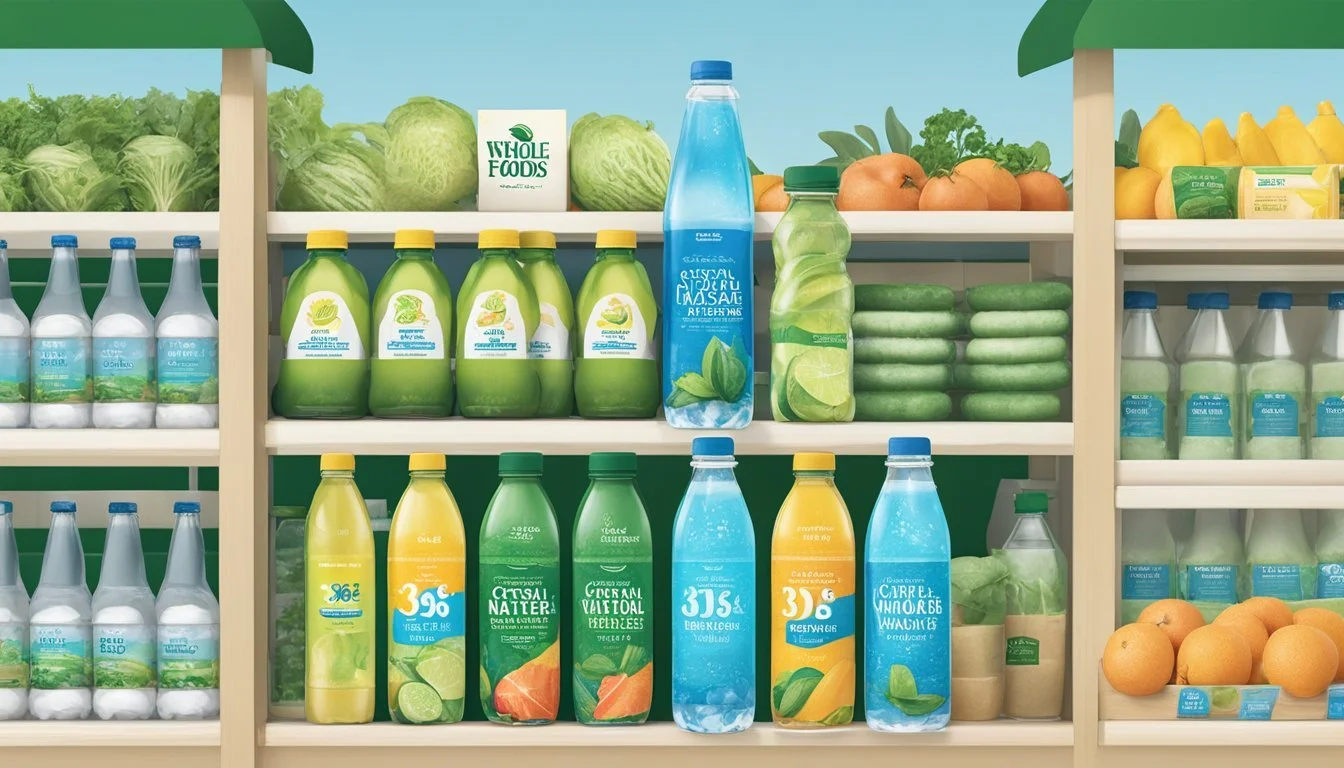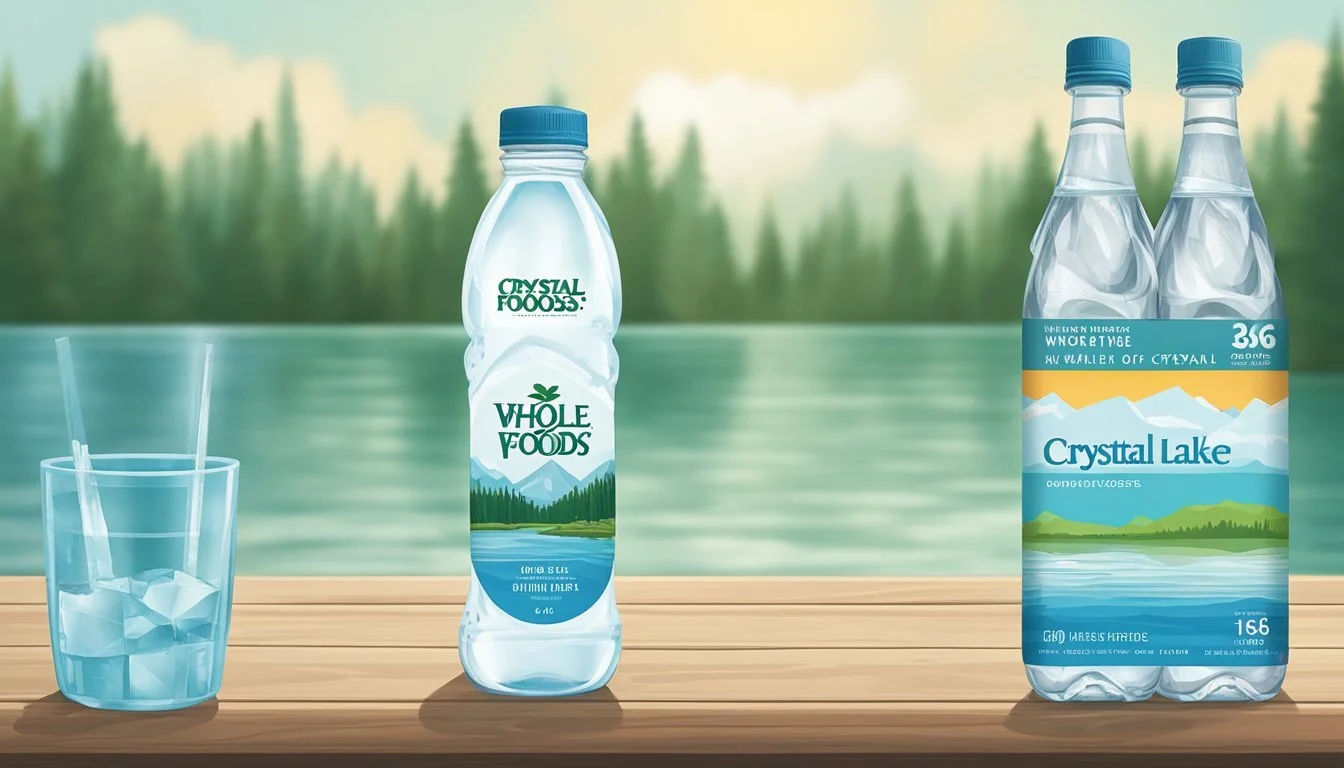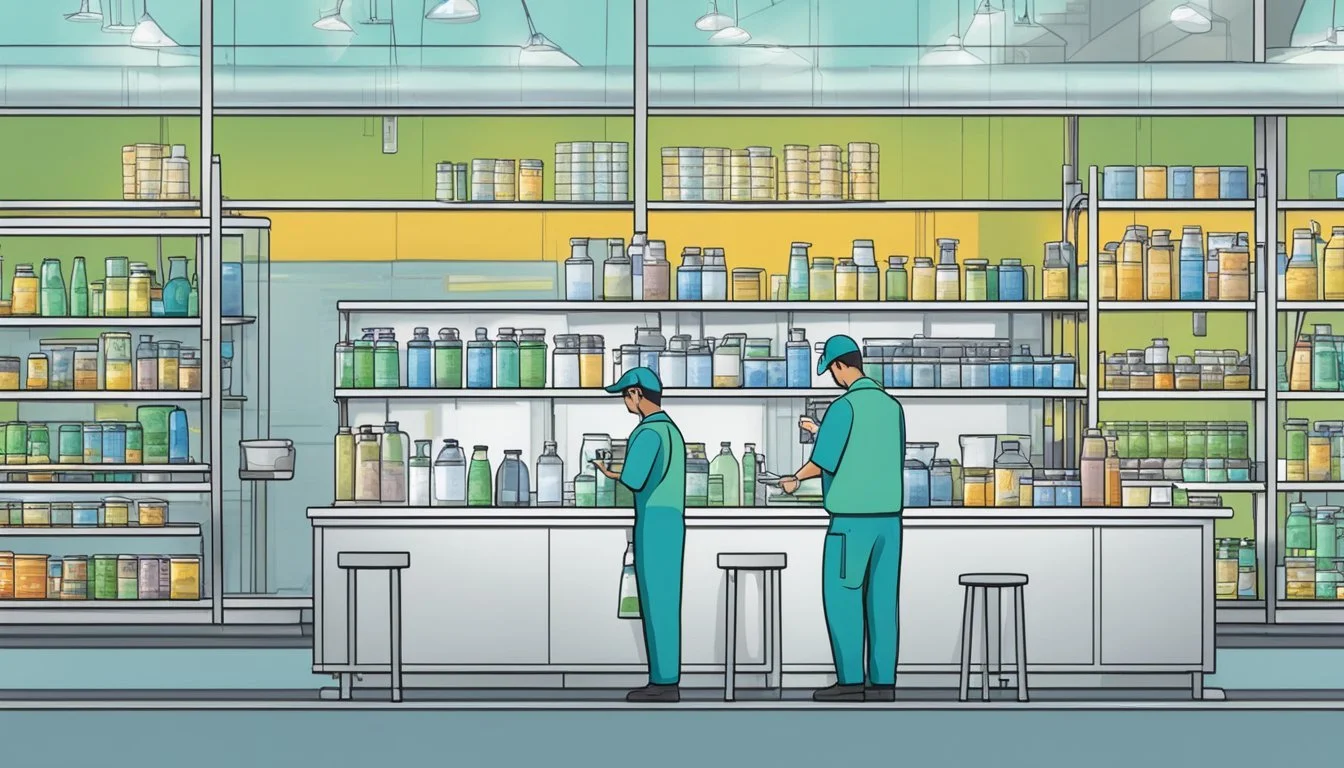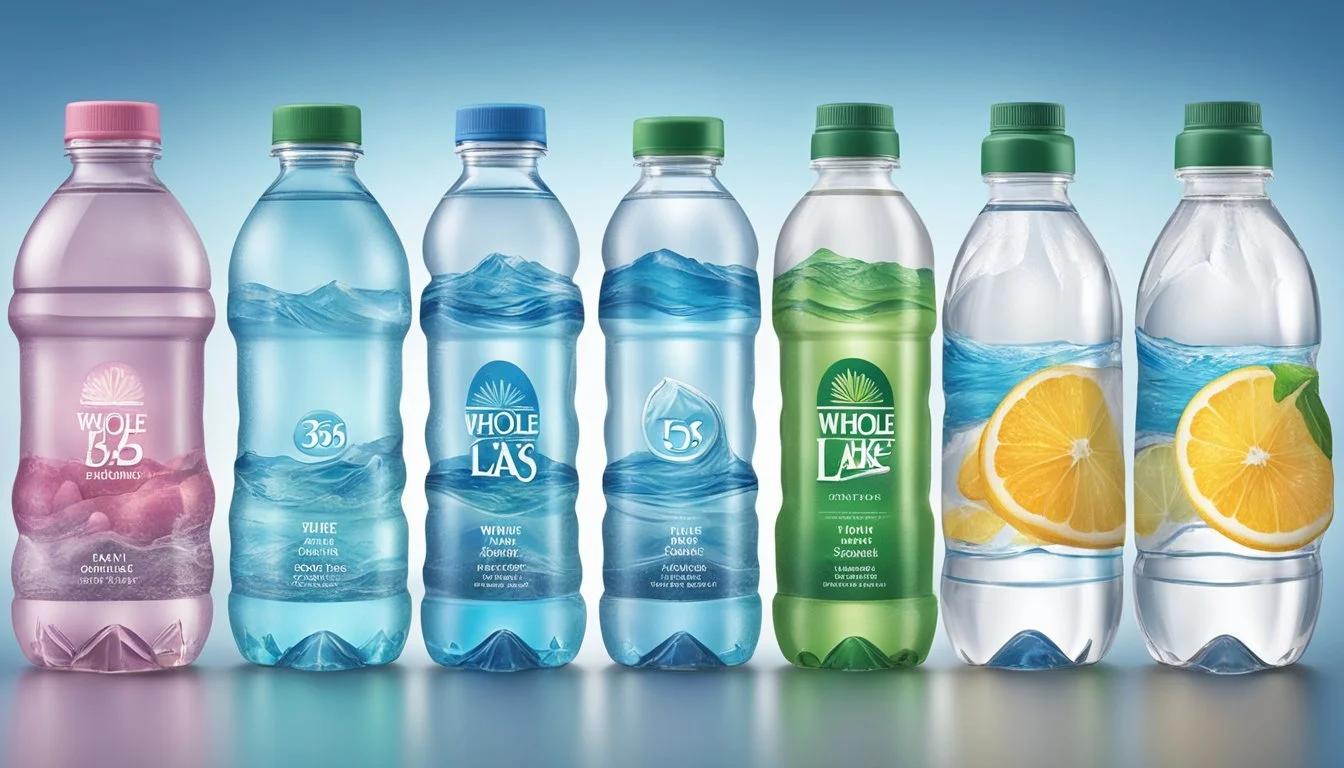Whole Foods 365 vs. Crystal Lake
Comparing Two Bottled Water Brands
When it comes to selecting bottled water, many consumers find themselves deciding between popular brands like Whole Foods 365 and Crystal Lake. While both waters are spring-sourced, they come with distinct flavors and price points. Whole Foods 365 offers a more accessible option at 69 cents per bottle, but some reviews mention a sour, dry aftertaste.
In contrast, Crystal Lake water often boasts a fresher, cleaner taste. This difference in taste quality can significantly influence purchasing decisions. Knowing these key distinctions helps consumers make a more informed choice when choosing their preferred bottled water.
Understanding the nuances between these two brands is crucial for those prioritizing taste and cost. By comparing both, readers can determine which brand better suits their needs.
Comparative Overview of Whole Foods 365 and Crystal Lake Bottled Water
Whole Foods 365: This brand offers a variety of water options, including spring, alkaline, and electrolyte waters. Crystal Lake: Known for its natural spring water, Crystal Lake emphasizes its minimal processing and high mineral content.
Price points for Whole Foods 365 range from $0.79 to $1.29. Crystal Lake is slightly higher, typically priced around $1.50 per liter.
Both brands market their spring water as natural and minimally processed. Whole Foods 365 is sourced from multiple locations, whereas Crystal Lake focuses on a single source for consistency.
When it comes to taste, Whole Foods 365 spring water is often described as clean with a dry aftertaste, while Crystal Lake's water is noted for its rich mineral flavor.
Packaging: Whole Foods 365 offers various sizes from 500 mL to one liter. Crystal Lake is available primarily in one-liter and larger containers.
Availability: Whole Foods 365 is widely available in Whole Foods Market stores. Crystal Lake can be found in select grocery stores and online.
Both brands use eco-friendly packaging, with Whole Foods 365 emphasizing its commitment to sustainability. Crystal Lake uses BPA-free plastic bottles to minimize environmental impact.
In summary, Whole Foods 365 and Crystal Lake cater to different tastes and preferences, with Whole Foods 365 focusing on variety and affordability, while Crystal Lake highlights its rich mineral content and single-source purity.
Understanding Bottled Water: Types and Definitions
When comparing bottled water options like Whole Foods 365 and Crystal Lake, it's essential to understand the types and definitions of bottled water available. These categories can include spring water, purified water, mineral water, and sparkling water, each with unique characteristics.
Spring Water vs. Purified Water
Spring Water is sourced from underground formations and flows naturally to the surface. This type of water is often praised for its natural minerals and is usually untreated, retaining its mineral content. Examples include brands like Evian and Whole Foods 365.
Purified Water, on the other hand, can come from any water source but undergoes purification processes such as distillation, deionization, or reverse osmosis to remove impurities. This process ensures that the water meets specific quality standards. Brands like Aquafina often fall into this category, with pH levels ranging between 5.5 to 7.0.
Both types aim to provide clean and safe drinking water, but their treatment processes and mineral content vary significantly. Understanding these differences can help consumers make informed choices based on their preferences and health needs.
Mineral Water and Sparkling Water Nuances
Mineral Water contains a higher concentration of minerals, occurring naturally or added deliberately. These minerals can include calcium, magnesium, and potassium. Mineral water sources must be naturally protected to maintain purity, and brands like Perrier and San Pellegrino are well-known for their rich mineral profiles.
Sparkling Water is characterized by its effervescence, achieved by carbonating the water with carbon dioxide gas. This category includes beverages like club soda and seltzer water. Club soda often has added minerals such as sodium bicarbonate and potassium sulfate, while seltzer water is simply carbonated without additional minerals.
These nuances play a significant role in the taste and health benefits of the water. When choosing between products like Whole Foods 365 and Crystal Lake, understanding these differences can guide consumers toward their ideal water type.
Health and Quality Considerations in Water Consumption
Consumers are often concerned with the health benefits and safety of their bottled water. This section examines the key aspects of mineral content, safety standards, and regulatory oversight to provide a clear understanding of what constitutes quality water.
Evaluating Mineral Content and Health Benefits
The mineral content of bottled water can significantly affect its health benefits. Crystal Geyser is known for its natural spring water, which contains minerals such as calcium and magnesium. These minerals can contribute to better hydration and may aid in bone health.
On the other hand, Whole Foods 365 bottled water offers various types, including spring, alkaline, and electrolyte water. Each type has different mineral compositions. For instance, alkaline water often has a higher pH level, which some believe helps to balance body acidity, although scientific evidence is mixed.
Mineral-rich waters can also enhance the taste, making it a preferable choice for many consumers. However, the benefits also depend on individual dietary needs and conditions.
Safety Standards and Contaminant Testing
Both Whole Foods 365 and Crystal Geyser must meet stringent safety standards to ensure consumer safety. These brands undergo regular testing for contaminants like PFAS (per- and polyfluoroalkyl substances). Whole Foods 365 has faced scrutiny in the past for PFAS levels, but they adhere to state guidelines and perform necessary safety checks.
Crystal Geyser takes a similar approach, continuously testing their water for a range of contaminants. They claim to exceed the minimum safety requirements dictated by federal and state regulations. Consumers should look for transparency in testing reports to gauge a brand’s commitment to safety.
Reliable testing methods and results contribute to the overall health benefits and trustworthiness of bottled water brands.
Role of the FDA and EPA in Regulation
The FDA (Food and Drug Administration) and EPA (Environmental Protection Agency) play crucial roles in regulating bottled water quality. The FDA oversees bottled water regulations, ensuring safe packaging and marketing. They set limits on contaminants and enforce labeling requirements.
The EPA, on the other hand, regulates public drinking water but sets the standards that the FDA often mirrors for bottled water. Their Safe Drinking Water Act outlines the legal standards for contaminants, which both entities follow closely.
Understanding the roles of these organizations helps consumers feel confident in the safety and quality of their bottled water. These stringent regulations ensure that products like Whole Foods 365 and Crystal Geyser are safe for consumption.
Source and Production Analysis
Whole Foods 365 and Crystal Lake bottled waters differ significantly in their sources, sourcing practices, and production processes. These differences impact taste, quality, and customer preference.
Natural Sources and Sourcing Practices
Whole Foods 365 sources its water from various natural springs, ensuring that the origins meet strict environmental standards. The water undergoes minimal processing to maintain its natural mineral content. The company emphasizes sustainability in its sourcing practices, often selecting springs located in eco-friendly regions.
Crystal Lake also sources its water from natural springs, but with an added focus on purity. By choosing springs known for their clean and crisp water, Crystal Lake aims to deliver a more pronounced, refreshing taste. The brand prioritizes locations with low pollution levels, ensuring the water retains its natural purity and minimal contaminants.
| Brand | Source Type | Sourcing Practices |
|--------------------|------------------|--------------------------------------|
| Whole Foods 365 | Natural Springs | Environmentally sustainable |
| Crystal Lake | Natural Springs | Focus on purity and low pollution |Bottling Process and Quality Control Measures
Whole Foods 365 implements a thorough bottling process, incorporating multiple filtration stages to remove any impurities. The water is bottled at state-of-the-art facilities that adhere to stringent quality control measures. Each batch is tested for contaminants, ensuring the final product meets high safety and quality standards before reaching consumers.
Crystal Lake employs a similar rigorous bottling process. The water undergoes advanced filtration and is bottled in facilities that comply with industry regulations. Quality control is a critical facet of their production, with frequent testing and adherence to safety protocols. This meticulous approach guarantees that Crystal Lake water maintains its advertised purity and taste consistency.
| Brand | Bottling Process | Quality Controls |
|--------------------|-----------------------------|---------------------------------------|
| Whole Foods 365 | Multiple filtration stages | Stringent testing for contaminants |
| Crystal Lake | Advanced filtration process | Regular quality and safety testing |Both brands highlight their dedication to sourcing high-quality water and maintaining rigorous production standards, ensuring consumers receive a product that meets their expectations.
Comparing Taste Profiles and Aftertaste
Whole Foods 365 offers a clean, crisp taste that makes it a popular choice among consumers. The water has a refreshing quality that feels light on the palate. The aftertaste is minimal, which many find appealing.
Crystal Lake provides a slightly different experience. Its taste is often described as having a hint of minerality. This gives it a distinctive flavor that stands out. The aftertaste is more pronounced compared to Whole Foods 365, lingering a bit longer but without any off-putting notes.
Brand Taste Profile Aftertaste Whole Foods 365 Clean, crisp, and light Minimal and brief Crystal Lake Slight minerality, distinctive Pronounced but not off-putting
Whole Foods 365's taste remains consistently smooth, making it a reliable option for those who prefer subtle flavors. Crystal Lake can be more rewarding for those who enjoy a touch of minerality in their water, providing a unique alternative.
Both brands strive to deliver quality water experiences, yet they cater to different preferences. The choice between them often comes down to whether someone values a clean, straightforward taste or a more distinctive, mineral-infused profile.
Packaging and Environmental Impact
The environmental footprint of bottled water significantly varies based on the type and materials of packaging used. It's important to examine the sustainability of bottle materials as well as the waste management and recycling initiatives undertaken by these brands.
Analyzing Bottle Materials and Sustainability
Whole Foods 365 Spring Water and Crystal Lake use different packaging materials that impact their sustainability. Whole Foods 365 often utilizes plastic bottles, which are widely used in the bottled water industry due to their lightweight nature. However, plastic poses significant environmental concerns due to its non-biodegradable nature.
Crystal Lake, on the other hand, tends to package its water in glass bottles. Glass is more environmentally friendly compared to plastic as it is easier to recycle and does not leach chemicals. Additionally, glass bottle production emits fewer CO2 emissions than plastic. Yet, the downside is the higher energy required for production and transportation due to the heavier weight.
Waste Management and Recycling Initiatives
Both brands have implemented various waste management and recycling initiatives to mitigate their environmental impact. Whole Foods 365 promotes recycling by ensuring their plastic bottles are made from recyclable materials. They encourage consumers to recycle through clear labeling and education efforts.
Crystal Lake focuses on reusable packaging systems, especially with their glass bottles. They have systems in place to collect, sterilize, and reuse these bottles, reducing waste significantly. Consumers can often return used bottles for a deposit, which incentivizes recycling and supports a circular economy.
The efforts made by both brands highlight the importance of sustainable practices in the bottled water industry. Through strategies like using recyclable materials and promoting bottle reuse, they strive to lessen their ecological footprint.
Consumer Insights and Brand Perception
Whole Foods 365 and Crystal Lake are two distinct bottled water brands each with their own market presence and values. Understanding their consumer perceptions and transparency can help determine which brand stands out.
Market Presence and Consumer Reports Reviews
Whole Foods 365 and Crystal Lake have made significant strides in the crowded bottled water market. According to Consumer Reports, Whole Foods 365 is well-regarded for its commitment to quality and organic products. On the other hand, Crystal Lake, carried by Rite Aid, is seen as a premium option, albeit its market presence is comparatively smaller and more niche.
Consumer Reports found potential contaminants in various bottled water brands. Whole Foods 365 generally passes safety checks, while Crystal Lake has had mixed reviews. Some consumers prefer Whole Foods 365 for its reliability, while others lean towards Crystal Lake for its taste and premium branding.
Brand Values and Transparency in Communication
Whole Foods champions values like sustainability, quality, and maintaining high standards. Whole Foods 365 bottled water is marketed as adhering to these values, emphasizing natural, clean sources. Their transparency in labeling and open communication about water sources resonate with health-conscious consumers.
Crystal Lake positions itself as a premium brand but lacks the robust transparency found in Whole Foods 365. While it appeals to those seeking luxury, some consumers question its source and processing details. Transparency in communication is limited compared to Whole Foods. Consumers appreciate brands that align with their values and provide clear, honest information.
Safety Concerns and Contaminants Analysis
Examining the safety of Whole Foods 365 and Crystal Lake bottled water reveals vital information about contaminants and their impact on public health. Specific attention is given to PFAS, lead, heavy metal content, and reported safety breaches.
Addressing PFAs, Lead, and Heavy Metal Content
Contaminants such as PFAS chemicals, lead, and heavy metals pose significant risks. PFAS (per- and polyfluoroalkyl substances) are a group of synthetic chemicals linked to serious health issues, including cancer. Testing has shown the presence of these chemicals in bottled waters, raising concerns.
Consumer Reports found PFAS contaminants in various bottled water brands, including both still and sparkling types. Whole Foods 365 and Crystal Lake are not exempt from scrutiny. Detailed lab analyses are crucial in assessing their PFAS levels.
Lead and heavy metals are also concerning. Even low levels can have adverse health effects, especially in children. Both brands must meet stringent regulatory standards. Regular testing and transparency in results help ensure consumer safety.
Investigations on Safety Breaches and Public Health
Safety breaches in the bottled water industry can have profound implications for public health. Investigative journalism has brought several instances to light. Scrutiny over the past decades has revealed breaches and contamination incidents.
Crystal Lake faced public criticism over previous safety lapses. Investigations uncovered lapses in quality control, highlighting the need for rigorous standards. In contrast, Whole Foods 365 has maintained a relatively clean record but remains subject to the same industry pressures.
Public health implications are significant. Consumers depend on these products for safe drinking water. Ensuring contaminants are identified and addressed is critical. Regulatory agencies and independent watchdogs play crucial roles in maintaining safety standards.
Both brands must continuously improve and adhere to rigorous safety protocols. Transparent reporting and accountability are fundamental to protecting public health and maintaining consumer trust.
Water Enhancements and Varietal Differences
Whole Foods 365 and Crystal Lake offer unique features through their water enhancements and the varietal differences, including health additives and diverse flavor options.
Electrolytes and Additional Health Additives
Each brand offers enhanced options that cater to health-conscious consumers. Whole Foods 365 often includes added electrolytes such as potassium, magnesium, and calcium to boost hydration and muscle function. These additions are beneficial for athletes and those seeking optimal hydration levels.
Crystal Lake also provides electrolyte-infused varieties and sometimes includes additional health additives like vitamins B and C. This can aid in general wellness and enhance the immune system. The availability of such enhanced options varies and is typically indicated on the packaging.
Flavored and Carbonated Options
For those seeking more than just plain water, both brands offer flavored and carbonated variants. Whole Foods 365 provides a range of natural flavors such as lemon, lime, and berry, using plant-based extracts while avoiding artificial sweeteners and colors.
Crystal Lake features both flavored and sparkling options, with popular choices including citrus and tropical flavors. Their carbonated waters provide a refreshing alternative to sugary sodas and are often preferred for their crisp taste.
Comparing these varietal differences can help consumers choose the best option based on personal preferences and health goals.
Conclusion
After a detailed comparison, several key points emerge between Whole Foods 365 and Crystal Lake bottled water.
Water Source and Purity
Whole Foods 365 is sourced from spring water with a pH range between 6.8 to 7.5. Crystal Lake boasts a similar source but maintains a strict filtration process.
Taste Profile
Whole Foods 365 has been noted to have a sour and dry aftertaste. Crystal Lake offers a cleaner, crisper taste which some consumers find more refreshing.
Availability and Cost
Whole Foods 365: Widely available at Whole Foods stores with a competitive price of 69 cents per bottle.
Crystal Lake: Available through various retailers, typically a bit more costly but highly rated for taste.
Key Differences
Feature Whole Foods 365 Crystal Lake Source Spring Water Spring Water pH Level 6.8 - 7.5 7.0 - 8.0 Taste Sour, Dry Aftertaste Clean, Crisp Price $0.69 per bottle Slightly higher but varies
Consumer Opinions
Whole Foods 365: Mixed reviews with some disliking the taste but appreciating its affordability.
Crystal Lake: Generally positive reception focusing on its superior taste and perceived quality.
Sodium and Additives
Whole Foods 365: Lacks added chemicals or preservatives.
Crystal Lake: Also free from artificial additives.
Each brand offers distinct characteristics, catering to different consumer preferences. Readers can use this comparison to make a more informed choice when selecting between these two bottled water brands.
More About Whole Foods 365
More About Crystal Lake
Aqua Carpatica vs Crystal Lake: Which Bottled Water is Better?
Cascade Mountain vs Crystal Lake: Which Bottled Water is Better?
Core Hydration vs Crystal Lake: Which Bottled Water is Better?
Crystal Geyser vs Crystal Lake: Which Bottled Water is Better?
Crystal Lake vs Essence pH10: Which Bottled Water is Better?
Crystal Lake vs Proud Source: Which Bottled Water is Better?
Hawaii Volcanic vs Crystal Lake: Which Bottled Water is Better?
Hawaiian Springs vs Crystal Lake: Which Bottled Water is Better?
Ice Mountain vs Crystal Lake: Which Bottled Water is Better?
Icelandic Glacial vs Crystal Lake: Which Bottled Water is Better?
Kirkland Signature vs Crystal Lake: Which Bottled Water is Better?
Liquid Death vs Crystal Lake: Which Bottled Water is Better?
Mountain Valley Spring Water vs Crystal Lake: Which Bottled Water is Better?
Nestle Pure Life vs Crystal Lake: Which Bottled Water is Better?
Poland Spring vs Crystal Lake: Which Bottled Water is Better?
Purely Sedona vs Crystal Lake: Which Bottled Water is Better?
Richard's Rainwater vs Crystal Lake: Which Bottled Water is Better?
San Pellegrino vs Crystal Lake: Which Bottled Water is Better?
Simple Truth vs Crystal Lake: Which Bottled Water is Better?
Solan de Cabras vs Crystal Lake: Which Bottled Water is Better?
Talking Rain AQA vs Crystal Lake: Which Bottled Water is Better?
Whole Foods Italian Still Mineral water vs Crystal Lake: Which Bottled Water is Better?






